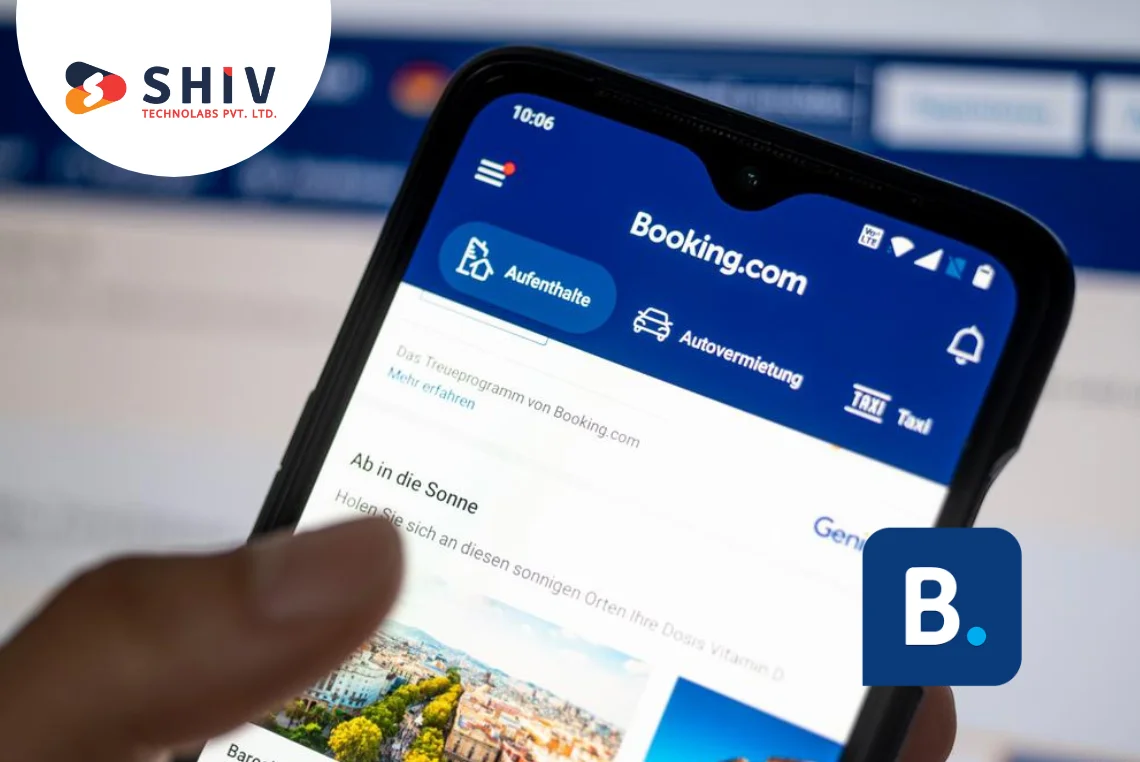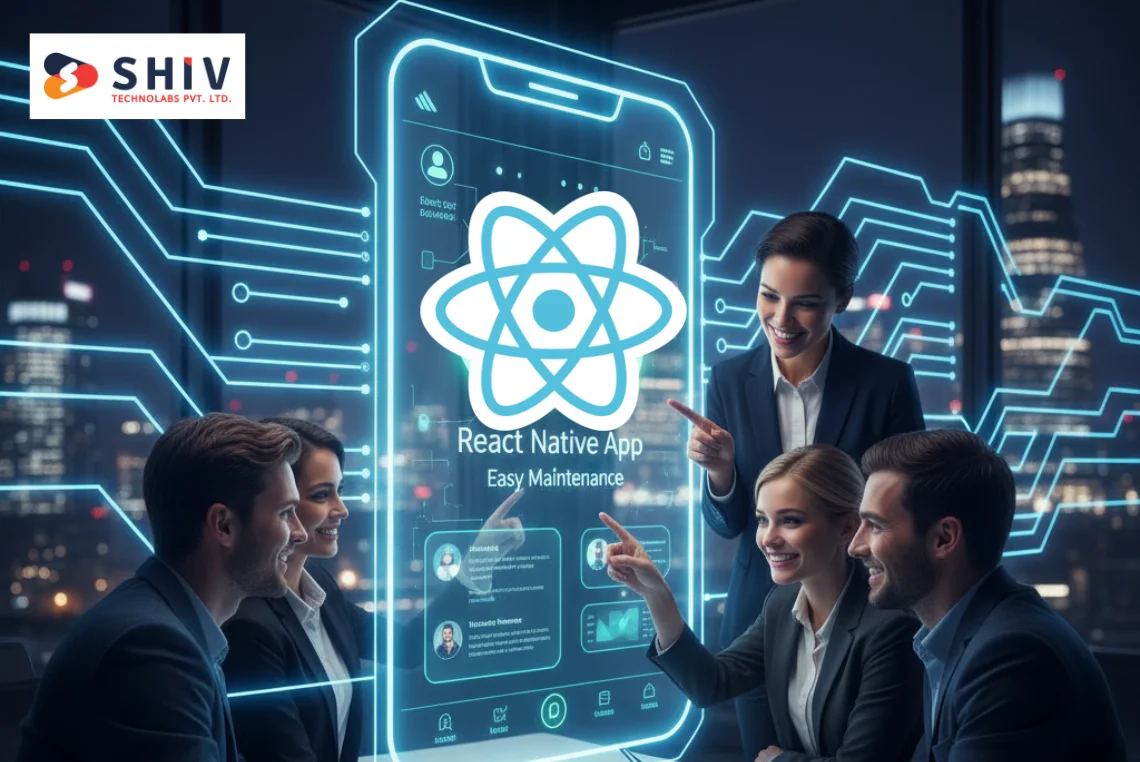Table of Contents
The travel industry has moved from ticket counters to one-tap bookings. Apps like Booking.com changed how people plan trips by making reservations quick, transparent, and accessible from anywhere.
But travelers in 2025 want more. They expect apps that understand preferences, offer better deals, and plan entire trips — not just hotel stays. That’s why creating a smarter travel app means going beyond what Booking.com offers.
It’s not about copying its model but improving it through AI, automation, and personalized travel experiences. With the right technology and design, your app can serve travelers faster, smarter, and more intuitively.
In this blog, we’ll discuss how to build a travel app like Booking.com, the must-have features, tech stack, cost, and how you can bring your travel app idea to life with a modern approach.
Why Travel Apps Like Booking.com Still Dominate the Travel Industry?
Over the years, Booking.com has become more than a travel app — it’s a trusted companion for millions of travelers. Its success lies in one simple truth: people want instant access, verified choices, and flexibility when planning their trips.
Even in 2025, such apps dominate because they combine convenience with credibility. According to Statista, over 70% of travelers prefer booking trips through mobile apps instead of websites. That number continues to rise as travelers rely on personalized recommendations and real-time pricing updates.
Here’s why travel apps like Booking.com continue to lead:
- Instant availability: Users can compare hotels, flights, or rentals in seconds.
- Trust and transparency: Verified reviews and flexible cancellation options build confidence.
- Personalization: AI-driven suggestions make every search more relevant.
- Multi-device experience: Everything syncs — from mobile to web.
- Rewards and loyalty: Points, discounts, and reminders keep users coming back.
However, these platforms are not flawless. Many still lack real-time personalization, AI-based trip planning, and niche-focused travel options — areas where new apps can outperform them.
This opens up an exciting opportunity for businesses and startups to build travel apps that go beyond booking — apps that truly assist travelers at every stage, from planning to post-trip reviews.
Key Features Every Smart Travel App Must Have
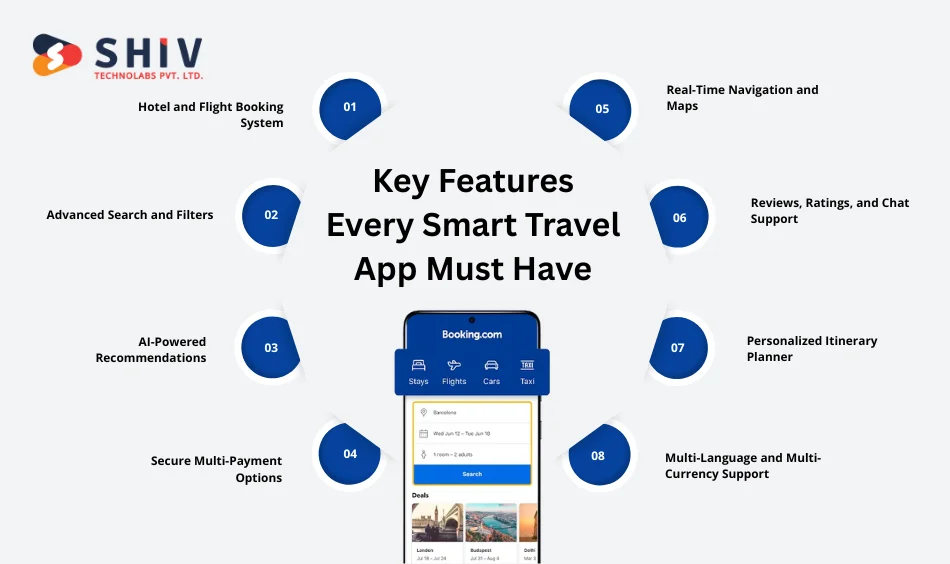
If you’re planning to build a travel app like Booking.com, the difference lies in features that improve the traveler’s journey — not just listings or filters. Modern users expect fast, relevant, and reliable tools that simplify every stage of their trip.
Here are the must-have features to include 👇
1. Hotel and Flight Booking System
Let users book hotels, flights, or rentals directly within the app. Integrate APIs from providers like Skyscanner or Amadeus for real-time pricing and availability.
2. Advanced Search and Filters
Travelers want precision. Filters for price, rating, distance, and amenities make search results faster and more accurate — especially for mobile users.
3. AI-Powered Recommendations
AI helps users find the right stay or package based on past behavior, travel history, and budget preferences. It’s what makes your app “smarter” than a standard booking platform.
4. Secure Multi-Payment Options
Offer card payments, wallets, UPI, and currency conversion for international users. Make the payment process fast and reliable.
5. Real-Time Navigation and Maps
Integration with Google Maps helps users locate hotels, nearby attractions, and transit options. It improves in-app engagement and usability.
6. Reviews, Ratings, and Chat Support
Travelers depend on peer feedback. Allow users to share experiences, and integrate chat support or bots to solve queries instantly.
7. Personalized Itinerary Planner
Let users build custom itineraries — flights, stays, and sightseeing in one place. This feature alone makes your app stand out from regular booking tools.
8. Multi-Language and Multi-Currency Support
A must for global travelers. Supporting multiple languages and currencies expands your app’s reach to different regions and audiences.
Smart travel apps win because they think like travelers — combining convenience, personalization, and trust.
How to Build a Travel App Like Booking.com – Step-by-Step Process
Here’s a concrete, travel-domain process that maps to real modules you’ll ship—not a generic app checklist.
1) Product & Supply Strategy (Weeks 1–2)
- Pick business model: Aggregator (APIs like Amadeus/Duffel/Expedia Rapid), Direct contracts, or Hybrid.
- Supply coverage: Cities, chains, independents, alt-stays. Target % of properties per city (e.g., 60% in Tier-1).
- Rate rules: Prepay vs pay-at-property, free cancellation windows, no-show policy, overbooking fallback.
Outputs: Supply roadmap, rate policy doc, refund matrix, and early city list.
2) Connectivity & Inventory Ingestion (Weeks 2–6)
- Hotel channels: Booking.com Connectivity, Expedia Rapid, SiteMinder, Cloudbeds, STAAH, RateTiger.
- Flights (optional): Amadeus Self-Service, Duffel, Skyscanner, or NDC with selected airlines.
- Data model: Properties → Rooms → Rate Plans → Allotments → Restrictions (min/max stay, advance purchase).
- Sync: Webhooks + cron pulls; define TTLs per feed (e.g., availability 5–15 min, static content 24–48 hrs).
- Deduping: Cluster listings by address + geo + phone; keep the strongest photo set and amenities.
Acceptance tests:
- Import 50k+ rooms; zero orphan rooms; allotment matches supplier counts; duplicate rate plans <1%.
3) Content Quality & Merchandising (Weeks 4–8)
- Photos: Minimum 8 per room; auto-tag amenities; compress + WebP; safe-crop for cards.
- Amenities schema: Wifi speed, breakfast type, parking rules, pet policy, accessibility tags.
- Neighborhood data: Walk scores, transit proximity, POIs; map tiles + clustering for dense cities.
- Price calendar: 365-day calendar with nightly price hints and blackout badges.
KPIs: Photo completeness %, amenity coverage %, and map interaction to filter conversion.
4) Search, Ranking & Personalization (Weeks 6–10)
- Indexing: Geo + price + date + availability in Elasticsearch/OpenSearch with numeric range filters.
- Ranking signals: Price vs peers, location, review score, cancellation flexibility, popularity, and margin.
- Learning-to-rank: Clicks, saves, expand-photo, checkout starts; re-rank per session.
- Personalization: Traveler type (solo/family/work), previous stays, budget bands, preferred chains.
Experiments:
Default sort A/B (Recommended vs Price); “Flexible dates” nudge; map-first vs list-first.
5) Pricing, Taxes & Parity (Weeks 7–11)
- Parity checks: Compare rates across suppliers; surface best-of-many with provenance tag.
- Fees & taxes: Local VAT/GST, city tax, resort fees; show split of base vs tax; invoice rules per country.
- FX & rounding: Mid-market feed + markups; lock rate at checkout; show hold vs charge in summary.
Guardrails: No hidden fees; parity breach alerting; nightly job to reconcile totals.
6) Booking Engine & Policy Logic (Weeks 8–12)
- Flows: Reserve with prepay, reserve with pay-at-property, hold with card guarantee.
- Policy engine: Cancellation windows, partial refunds, no-show penalties, and modification rules.
- Overbooking handling: Auto-reprotect—suggest nearest, same class or higher; one-tap voucher.
- Docs: Voucher PDFs, confirmation emails/SMS with ICS calendar add.
Happy-path SLAs: Search→Pay success > 97%; confirmation receipt < 6s median.
7) Payments, Risk & Compliance (Weeks 8–12)
- Gateways: Stripe/Adyen/PayPal + UPI where relevant; 3DS2, SCA, tokenization.
- Risk: Device fingerprint, velocity limits, BIN checks, high-risk country rules, and refund cooldowns.
- Compliance: PCI scope limited to gateway; GDPR/CCPA data flows; audit logs for PII access.
Dashboards: Auth rate by issuer, chargeback rate, and refund latency.
8) Post-Booking Care & Trust (Weeks 9–13)
- Support: In-app chat, supplier handoff notes, emergency phone line during check-in window.
- Self-serve: Modify dates (if policy allows), add guest names, request an invoice, and late checkout.
- Reviews: Verified-stay only; photo reviews; AI flagging for profanity or PII.
North stars: CSAT > 4.6/5, median chat first-response < 60s.
9) Mobile UX Details That Move the Needle (Parallel)
- Date picker: Price-aware calendar; “weekend”, “next long weekend”, “flex 1–3 days”.
- Filters that matter: Free cancellation, breakfast, bed type, parking, pet-friendly, work desk + wifi Mbps.
- Cards: Photo + score + badges (Free cancel / Pay at hotel / Breakfast).
- Itinerary: Trip folder with bookings, maps, offline access, and receipts.
10) Observability, SLIs & Incident Playbooks (Weeks 10–14)
- SLIs: Search p95, availability p95, checkout p95, supplier API error rate, timeout rate.
- Playbooks: Supplier outage fallback, partial booking stuck states, duplicate confirmations.
- Canaries: Shadow traffic against a synthetic city/date set; alarms on price spikes or null availability.
11) Launch Plan & Growth (Weeks 12–16)
- City-by-city launch: Start with 3 cities; reach supply and content thresholds before adding more.
- Acquisition: Metasearch feeds (Google Hotel Ads), affiliate program, creator trips, and corporate pilots.
- Monetization mix: Commission, featured placements, partner bundles, subscription for agencies.
Core metrics: Search→Detail, Detail→Checkout, Checkout→Book, cancellation %, gross margin per booking.
12) “Smarter Than Booking.com” Upgrades (Post-MVP)
- AI trip planner: Chat prompt → draft itinerary → bookable bundle.
- Dynamic pricing aid: Suggest a stay-shift for a cheaper total (±1 day) with transparent savings.
- Context packs: Family, pet, remote-work presets that pre-filter and pre-sort.
- AR previews: Room size and view approximation; lobby walkthroughs where partners allow.
Tech Stack for a Booking.com–Style Travel App
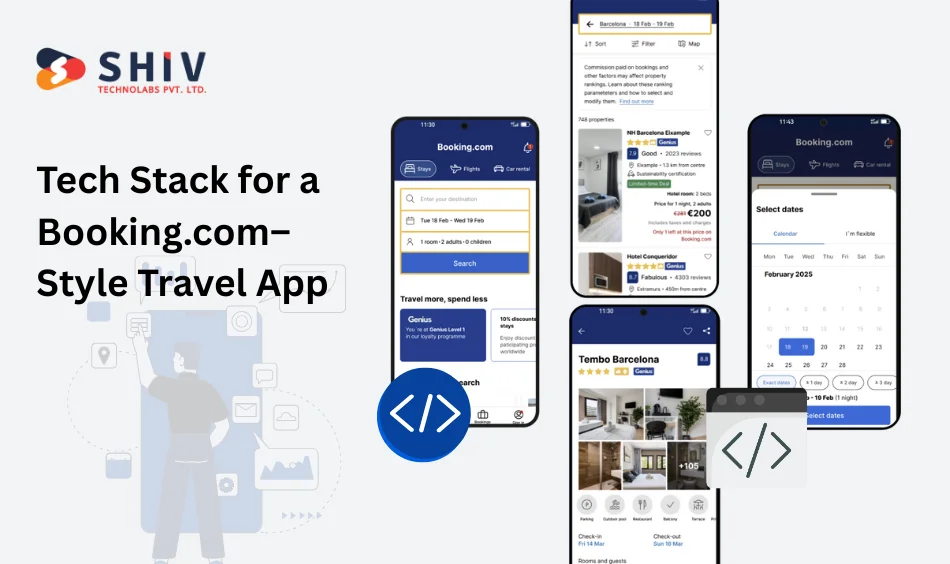
Pick tools around the modules you’ll ship. Each item maps to a phase in the travel-specific process.
1) Supply Connectivity & Ingestion
- Connectors: Amadeus, Duffel, Skyscanner, Expedia Rapid, Booking.com Partner, SiteMinder, Cloudbeds, STAAH.
- Ingestion jobs: Node.js (NestJS) or Python (FastAPI) workers with retry & backoff.
- Queueing: Kafka or RabbitMQ for feed spikes.
- Storage: PostgreSQL for properties/rooms/rate-plans; S3/GCS for photos and docs.
2) Deduping & Catalog Normalization
- Match service: Python with fuzzy matching (address/geo/phone) + embeddings for name variants.
- Reference data: City/POI gazetteers, ISO country/FX tables.
- Assets: Image dedupe via perceptual hashing; WebP conversion and responsive sizes.
3) Pricing, Taxes, and Parity
- Rate service: Rules for base, taxes, fees, FX, markups; lock price at checkout.
- Parity checker: Nightly cross-supplier compare with alerts when a cheaper source exists.
- Libraries: Money math with minor units (no float), tax tables per country/state.
4) Search, Filters & Ranking
- Index: Elasticsearch/OpenSearch with geo, date, price, and availability fields.
- Ranking signals: Location, review score, cancellation terms, margin, and popularity.
- Re-rank: Learning-to-rank on clicks, photo expands, and checkout starts.
- Maps: Google Maps/Places or Mapbox; tile clustering for dense areas.
5) Policy & Booking Engine
- Policy engine: Cancellation windows, partial refunds, no-show, and modification rules.
- Booking flows: Prepay, pay-at-property, and card-guarantee; voucher PDFs + ICS.
- State machine: Orchestrate “search → hold → pay → confirm”; reconcile stuck states.
6) Payments & Risk
- Gateways: Stripe, Adyen, Razorpay, PayPal; 3DS2/SCA, tokenization, refunds.
- Risk checks: Device fingerprint, velocity limits, BIN rules, high-risk geo flags.
- Wallets: UPI/NetBanking where relevant; multi-currency presentation.
7) Personalization & AI
- Profiles: Traveler type, budget bands, chain affinity, trip purpose.
- Recs: Vector DB (Pinecone/Weaviate) + rerankers for “similar stays” and “because you liked…”.
- Trip assistant: LLM with tools for dates, filters, and price-aware calendar edits (guardrails applied).
8) Content & Merchandising
- Amenity schema: Wifi Mbps, breakfast type, bed size, parking, pet policy, accessibility tags.
- Neighborhood layer: Walk scores, transit time, POIs with distance badges.
- Media: CDN (CloudFront/Cloudflare), lazy-load, safe-crop for cards and lists.
9) Apps & Admin
- Mobile: Flutter or React Native; price-aware calendar, offline trip folder, deep links.
- Web/Admin: Next.js dashboard for supply health, parity alerts, refund approvals, and content QA.
- Auth: OAuth 2.0, JWT, SSO (Google/Apple), role-based access.
10) Observability & Reliability
- Metrics: p95 for search, availability, checkout; supplier error/timeout rates.
- Stack: Prometheus + Grafana, Sentry, Loki; synthetic canaries for fixed city/date sets.
- Playbooks: Supplier outage fallback, overbooking re-protect, duplicate confirmation clean-up.
11) Analytics & Experiments
- Product analytics: PostHog or Mixpanel for funnels (Search→Detail→Checkout→Book).
- A/B: GrowthBook/FlagSmith feature flags; city-by-city rollouts.
- Attribution: Branch/Appsflyer for install and campaign tracking.
12) Security & Compliance
- Data: Field-level encryption for PII, scoped access logs, and deletion flows.
- Standards: PCI scope kept at the gateway, GDPR/CCPA data maps, audit trails.
- Traffic: TLS, WAF, rate limits, CAPTCHA on risky paths.
This stack ties directly to travel use-cases: rate-plan accuracy, parity, price-aware search, clear policies, strong payments, and post-booking care—without tech bloat.
Cost & Timeline Breakdown
Clear ranges help you plan. Below is a practical view for a Booking.com–style app built with the modules we outlined.
1. Phase-wise Plan
| Phase | What You Ship | Duration | Ballpark Cost (USD) |
|---|---|---|---|
| Discovery & Supply Strategy | Business model, cities list, rate/refund policy, KPIs | 2–3 weeks | 6,000–10,000 |
| Connectivity & Ingestion | Supplier APIs, feeds, queues, first 50k rooms | 3–5 weeks | 15,000–25,000 |
| Deduping & Catalog | Listing merge, amenity schema, photo pipeline | 2–3 weeks | 8,000–15,000 |
| Search & Ranking | Index, filters, default sort, map layer | 3–4 weeks | 15,000–22,000 |
| Pricing & Parity | Taxes/fees, FX rules, nightly parity checks | 2–3 weeks | 8,000–14,000 |
| Booking Engine & Policy | Hold → pay → confirm flows, vouchers, rules | 4–6 weeks | 20,000–35,000 |
| Payments & Risk | Gateways, 3DS2/SCA, fraud checks, refunds | 2–3 weeks | 8,000–14,000 |
| Apps & Admin | Mobile app, web, admin console, roles | 4–6 weeks | 22,000–40,000 |
| Post-Booking & Reviews | Chat, self-serve changes, verified reviews | 2–3 weeks | 7,000–12,000 |
| Observability & Analytics | Dashboards, alerts, funnels, flags | 2–3 weeks | 6,000–10,000 |
Subtotal (core build): $105,000–$197,000 over 4–6 months (parallel work reduces total time).
2. Packages (Scope Scenarios)
| Package | Who It Fits | Duration | Cost (USD) | What’s Inside |
|---|---|---|---|---|
| MVP | Single region, hotels only, prepay + pay-at-property | 10–12 weeks | 45,000–75,000 | Supplier API, search+filters, booking engine, Stripe/PayPal, basic admin, photo/amenity pipeline, parity light |
| Growth | Multi-city, hotels + alt-stays, loyalty basics | 16–20 weeks | 85,000–135,000 | All MVP + advanced ranking, price-aware calendar, parity jobs, refunds dashboard, verified reviews, in-app chat |
| Advanced | Global, flights add-on, re-protect flow, AI recs | 22–28 weeks | 150,000–260,000 | All Growth + flights, policy variants, AI suggestions, supplier outage playbooks, A/B infra, mobile + web polish |
3. Add-Ons (Pick as Needed)
| Add-On | Cost (USD) | Notes |
|---|---|---|
| Flights module (Amadeus/Duffel) | 18,000–35,000 | Search, fare rules, tickets, PNR basics |
| AI trip planner | 12,000–25,000 | Prompt → itinerary → bookable bundle |
| Loyalty & wallet | 8,000–18,000 | Points, tiers, vouchers, burn/earn |
| AR room previews | 10,000–22,000 | Limited partner support required |
| Corporate portal | 12,000–28,000 | Cost centers, approvals, GST/VAT invoice rules |
| Metasearch feeds (GHA) | 6,000–12,000 | Feed format, performance tuning |
Team & Rate Model (Typical Mix)
- Product + BA (part-time), PM, UX/UI
- 2–4 Backend devs (Node/Python), 1–2 Mobile, 1 Web
- QA (manual + automation), DevOps, Data/ML (if AI scope)
- Blended rate reference: $28–$48/hr (varies by skill and contract length)
4. Ongoing Costs (Monthly)
| Item | Range (USD) | What’s Included |
|---|---|---|
| Cloud & CDN | 800–3,500 | App servers, DB, storage, image processing, CDN |
| Monitoring & Logs | 150–600 | Sentry, Grafana stack, log storage |
| Third-party APIs | 300–2,000 | Maps, email/SMS, travel APIs (usage-based) |
| Maintenance & SRE | 2,500–6,000 | Bug fixes, hot patches, and incident drills |
| A/B & Analytics | 100–500 | PostHog/Mixpanel, flag service |
Key Variables That Affect Cost
- Supply plan: number of sources, regions, flights vs stays
- Policy complexity: refunds, partial charges, no-show handling
- Payment mix: gateways, currencies, local methods (e.g., UPI)
- Mobile depth: feature parity with web vs trimmed MVP
- AI scope: recs only vs full trip planner and pricing hints
Milestone Targets (Good Benchmarks)
- First searchable city: Week 6–8
- First booking end-to-end: Week 8–10
- Parity alerts live: Week 10–12
- Mobile beta on TestFlight/Play Console: Week 12–14
- City-by-city launch: Week 14 onward
Smart Upgrades to Make Your Travel App Stand Out
Building an app like Booking.com is only the start — standing out comes from how intelligently your app serves travelers. Modern users expect planning, assistance, and personalization in one experience. Here’s how you can make your version smarter:
- AI Travel Assistant: Integrate a conversational assistant that helps users plan trips based on preferences, budget, and travel time. It can suggest stays, flights, or nearby attractions, and even build day-by-day itineraries.
- Dynamic Pricing & Smart Deals: Use machine learning to analyze booking patterns, demand, and seasonality. This helps your app recommend flexible dates or alternate routes that save money — something traditional platforms often miss.
- Voice Search & Multilingual Queries: Allow users to search using natural speech — “Find hotels under $100 in Paris next weekend.” Combined with multilingual support, it improves accessibility for non-English travelers.
- AR-Based Room and Destination Previews: AR (Augmented Reality) lets travelers view hotel rooms or nearby attractions virtually before booking. It creates trust and reduces cancellation rates.
- Smart Notifications & Trip Insights: Push reminders for flight check-ins, weather updates, or visa alerts. Add insights like “You’re visiting during the local food festival” — information that adds real value.
- Loyalty System With Real Rewards: Reward returning users through points or credits redeemable for future stays. Integrate personalized discounts triggered by user milestones (like their fifth booking).
- Offline Mode & Quick Rebooking: Let users access their itinerary or tickets without the internet. Include a “one-tap rebook” option in case of cancellations or reschedules.
- Personalized Trip Feeds: Show content like nearby experiences, restaurants, and tours based on traveler profile and booking context. This keeps users engaged beyond checkout.
Each of these upgrades strengthens trust, engagement, and retention — helping your app compete not by price, but by experience.
Monetization Models for Travel Apps
A travel app becomes sustainable only when it generates consistent revenue. Instead of relying on a single source, modern apps combine multiple income streams — creating a balance between user value and business growth.
Here are proven monetization models used by leading platforms like Booking.com and Expedia:
- Commission per Booking: The most common model. You earn a percentage for every successful booking made through your platform. Example: charge 10–20% commission to hotels, tour operators, or airlines.
- Subscription Plans for Agencies: Travel agents or corporate users can subscribe to premium plans with advanced analytics, better support, or white-label dashboards. It ensures recurring income and stable partnerships.
- Featured Listings and Ads: Hotels or hosts can pay for higher visibility in search results. Use fair ranking logic — maintain transparency so paid listings don’t compromise user trust.
- Affiliate Partnerships: Integrate affiliate programs for car rentals, insurance, or attractions. Earn commissions when users book third-party services from within your app.
- Dynamic Packages and Upsells: Bundle hotels, flights, and activities for better pricing. Use AI to suggest relevant upgrades — for instance, adding airport pickup or travel insurance at checkout.
- Data Insights for Partners: Aggregate anonymized booking trends and pricing insights to share with travel businesses or marketing agencies. Be transparent about data policies and comply with privacy regulations.
- In-App Store or Marketplace: Offer travel gear, SIM cards, or vouchers. Integrate dropshipping or local partnerships to increase non-booking revenue.
A mix of these models keeps your app financially steady — allowing you to grow bookings while expanding into new travel services without heavy upfront dependency on ads or commissions alone.
Common Mistakes to Avoid in Travel App Development
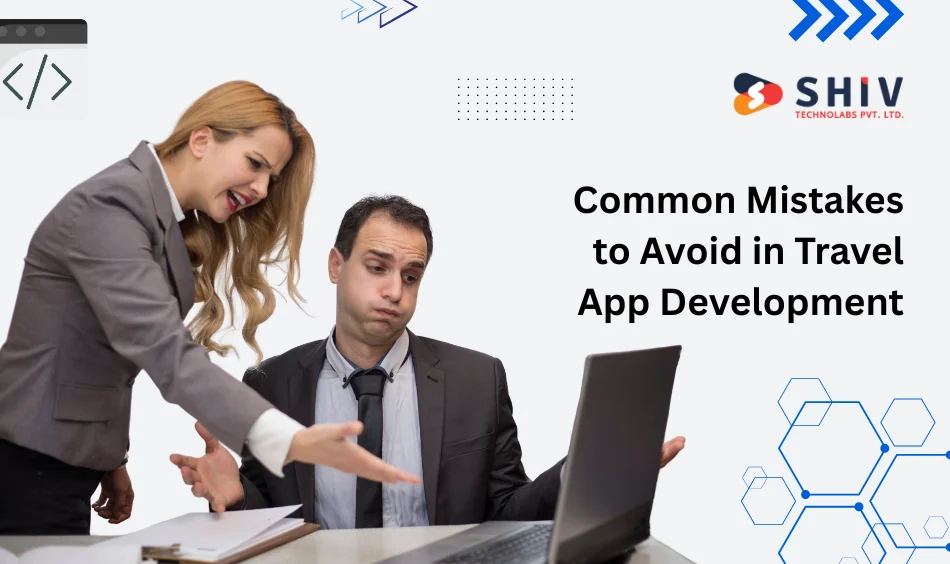
Many travel apps look promising at launch but fail to scale or retain users. The reason isn’t always competition — it’s the avoidable mistakes made during development and post-launch management. Here are the key ones to steer clear of:
1. Weak API Management
A travel app relies heavily on data from suppliers and aggregators. Ignoring proper caching or retries causes slow load times and price mismatches, frustrating users.
→ Tip: Use queue systems, fallback APIs, and scheduled syncs to maintain data accuracy.
2. Poor UX for Multi-Step Bookings
If the checkout feels long or confusing, travelers abandon it. Every extra click adds drop-off risk.
→ Tip: Keep booking flows short, use autofill for saved details, and allow guest checkouts.
3. Ignoring Mobile-First Design
Most users book on mobile, not desktop. Unresponsive layouts, small buttons, or hidden filters ruin conversions.
→ Tip: Prioritize mobile-first UI with clear CTAs, price visibility, and sticky “Book Now” buttons.
4. Missing Real-Time Price & Availability Updates
Outdated inventory causes double bookings or “room not available” errors.
→ Tip: Implement webhooks and periodic refresh jobs to sync data every few minutes.
5. Lack of Personalization
Showing every user the same deals reduces relevance and engagement.
→ Tip: Use behavioral data and past bookings to tailor search results and recommendations.
6. Overlooking Refund and Policy Transparency
Hidden fees or unclear refund rules destroy trust.
→ Tip: Display taxes, fees, and cancellation policies clearly before payment.
7. Neglecting Post-Booking Support
A strong booking system means little if users can’t modify or cancel easily.
→ Tip: Add self-service options and a quick “Chat with Support” feature inside the app.
8. No Plan for Scalability
Many apps aren’t built to handle API spikes or growing user traffic.
→ Tip: Use modular microservices and auto-scaling on cloud platforms.
Avoiding these mistakes helps your app stay stable, trustworthy, and scalable — three pillars that define every successful travel platform.
Partner With Shiv Technolabs to Build a Future-Ready Travel App
Building a travel app that competes with Booking.com takes more than coding — it needs strong architecture, reliable API handling, and traveler-first design. That’s where Shiv Technolabs brings real value.
Our team has hands-on experience developing AI-driven booking systems, dynamic pricing engines, and multi-supplier travel platforms that manage real-time data without lag. We work with startups and travel agencies to create applications that don’t just list hotels but plan entire journeys — from discovery to check-in.
Here’s what we deliver:
- Custom booking engines with multi-API integration (hotels, flights, tours)
- Personalized recommendation modules powered by AI
- Secure payment and refund workflows across currencies
- Mobile-first UX built for travelers, not developers
- Admin dashboards for pricing, reviews, and content control
Whether you’re a travel startup or a growing agency, we can help you launch faster, scale safely, and adapt smarter.
👉 Let’s turn your travel app idea into a global booking experience. Contact Shiv Technolabs to get started.
Conclusion
The travel industry isn’t slowing down — it’s getting smarter. Travelers now expect apps that save time, predict their choices, and simplify trip planning in one place. Platforms like Booking.com set the foundation, but there’s still space for new entrants who innovate through AI, automation, and user-first design.
Creating a travel app that’s smarter means blending technology with empathy — understanding what frustrates travelers and solving it better. With the right features, a reliable tech stack, and continuous improvement, your app can build long-term trust and strong repeat engagement.
If you’re ready to move beyond traditional booking experiences and build something that genuinely helps travelers travel better, this is the right time to begin. Partner with a team that understands both technology and travel — and turn your idea into the next big name in digital travel.
FAQs
1. How long does it take to build a travel app like Booking.com?
A typical MVP takes around 12 to 16 weeks, covering design, APIs, booking engine, and mobile app. A full-scale version with AI recommendations, reviews, and loyalty programs may take 5–7 months, depending on complexity.
2. What features make a travel app stand out in 2025?
Modern travel apps include AI-powered suggestions, real-time pricing, AR previews, and voice search. Features like personalized itineraries and multi-language support make them more useful and engaging.
3. Which APIs are best for travel app development?
Common choices include Amadeus, Skyscanner, Duffel, and Booking.com Partner APIs. They provide flight, hotel, and rental data in real time, which helps your app stay accurate and fast.
4. How much does it cost to develop a travel app like Booking.com?
The cost varies based on features and region. A basic MVP may cost around $45,000–$75,000, while a full-scale app with advanced modules and AI can range between $120,000–$250,000.
5. What tech stack is ideal for a travel booking app?
A proven stack includes Flutter or React Native for mobile, Node.js or Python for backend, and PostgreSQL for data. Add Elasticsearch for fast search and Stripe or Adyen for secure payments.
6. How do travel apps earn money?
Revenue models include commissions, featured listings, subscriptions, affiliate programs, and dynamic upsells. Combining multiple models ensures steady and scalable income.
7. Can AI improve the travel booking experience?
Yes, AI personalizes recommendations, predicts pricing trends, and even helps users plan trips through chat-based assistants. It’s the core of every next-generation travel platform.
8. Why should I work with Shiv Technolabs for travel app development?
Shiv Technolabs has experience in building scalable booking systems, integrating travel APIs, and creating AI-based personalization engines. We focus on performance, usability, and long-term growth — helping your travel app succeed globally.

